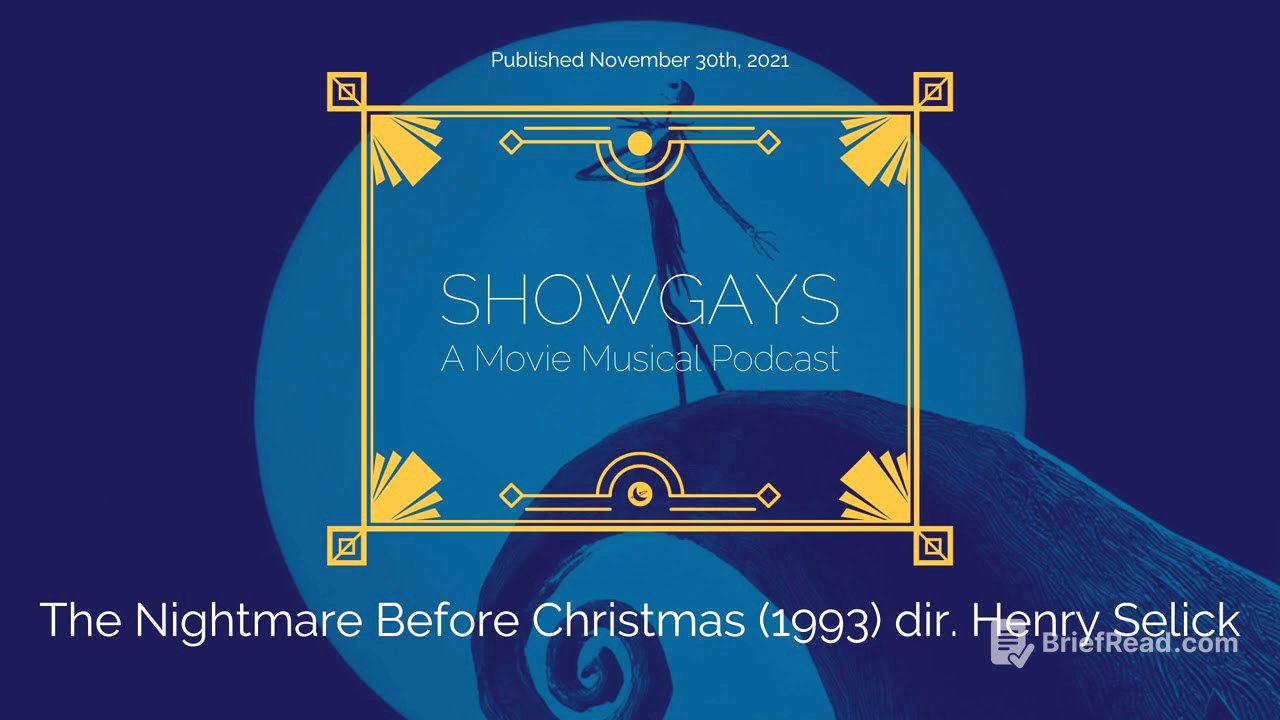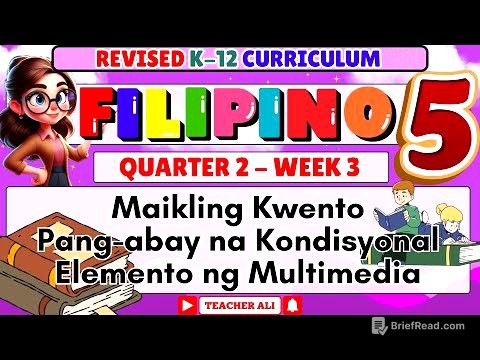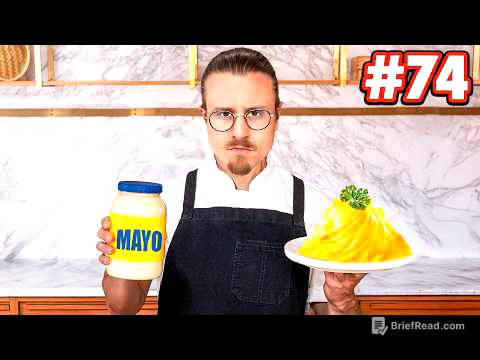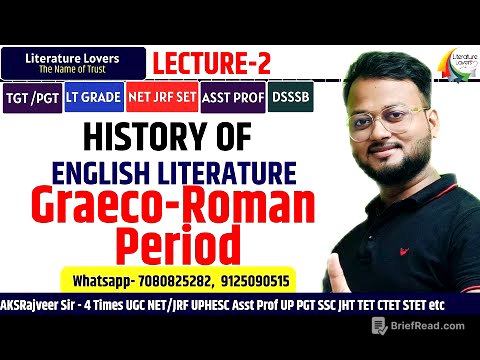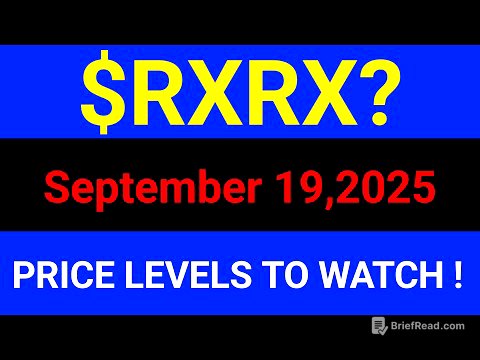TLDR;
The Ampliverse's podcast episode discusses "The Nightmare Before Christmas," covering its plot, music, characters, and cultural impact. The hosts share personal histories with the film, analyze its themes, and debate its merits as a musical. They also explore the movie's fandom and its place within Tim Burton's filmography.
- Plot and Characters
- Musical Analysis
- Cultural Impact and Fandom
Intro [0:00]
The episode starts with a comedic skit and transitions into introducing the topic: Tim Burton's "The Nightmare Before Christmas." The hosts express their enthusiasm and set the stage for a discussion about the film's emo and goth elements.
Challenge: RJ Summarizes the Plot [5:37]
RJ is challenged to summarize the plot of "The Nightmare Before Christmas" in one minute. He recounts Jack Skellington's dissatisfaction with Halloween, his discovery of Christmas, and his attempt to take over the holiday, which leads to chaos. RJ mentions Jack's eventual realization of his error and his return to Halloween. Molly notes the omission of Sally in the summary, leading to a discussion about her importance to the plot.
Personal History with the Movie [8:37]
The hosts share their personal experiences with "The Nightmare Before Christmas." Molly recalls encountering the film through Hot Topic merchandise in middle school and watching it later in high school, but not forming a strong emotional connection. Adam recounts watching it with his partner when they moved to Orlando, appreciating the music. They discuss Mickey's Not-So-Scary Halloween Party at Disney World, where the film's characters are featured.
Early Experiences and Parental Notes [13:20]
Molly shares her early experience watching the movie at a babysitter's house, remembering specific scenes and Dr. Finkelstein. She contrasts her lack of fear with her experience watching "Little Shop of Horrors." The hosts discuss parental feedback on previous episodes, including technical notes and praise for Molly's contributions.
Origins and Influences [18:34]
The hosts discuss the origins of "The Nightmare Before Christmas," noting it's based on a poem by Tim Burton from his time as a Disney animator. They mention Disney's initial hesitation and eventual release under Touchstone Pictures. The poem was inspired by "A Visit from St. Nicholas" and Rankin/Bass Christmas specials like "Rudolph the Red-Nosed Reindeer." The hosts highlight the technical achievements in stop-motion animation compared to earlier works.
Production Facts and Figures [25:43]
The hosts share facts about the movie's production, including the director Henry Selick, screenplay writer Caroline Thompson, and the voice cast. They discuss the film's budget, box office success, and initial release under Touchstone Pictures due to concerns about its darkness for children. They also mention actors who were considered for roles, such as Vincent Price and James Earl Jones.
Initial Reactions and Musical Analysis [32:40]
The hosts share their initial reactions to the movie, with one describing it as "style over substance," emphasizing the visuals and music over the plot. They discuss the film's memorable songs, particularly "This Is Halloween," and analyze why the music may not be as memorable as other musicals due to its unconventional structure. They explore the use of music as a narrative device and compare it to operatic recitative.
Music as Score and German Expressionism [37:46]
The hosts discuss how the music functions more as a score than traditional musical theater, noting the lack of big, emotional moments for belting. They explore the brilliance of "What's This?" in capturing the essence of Christmas and highlight the German Expressionist design of Halloweentown, combined with Dr. Seuss elements.
Character Movement and Sally's Role [46:32]
The hosts discuss the unique character movements in the film and the distinctive designs of the Halloweentown villagers. They analyze Sally's character, noting Catherine O'Hara's understated performance and the audience's quick attachment to her. They explore the romance aspect of the film and Sally's relationship with Dr. Finkelstein.
Sally's Character and Jack's Appeal [52:57]
The hosts continue discussing Sally's character design and Caroline Thompson's influence on her portrayal. They explore the romance between Sally and Jack, questioning Jack's appeal as a sex symbol. They discuss the enduring appeal of the "skinny white boy" archetype and reference a Saturday Night Live skit featuring Pete Davidson as Jack Skellington.
Henchmen Song and Oogie Boogie [1:03:17]
The hosts discuss the "Kidnap the Sandy Claws" song, comparing it to henchmen songs in other musicals. They analyze the humor and visual gags associated with Lock, Shock, and Barrel. The discussion transitions to Oogie Boogie, with one host expressing disgust at his bug-filled nature.
Oogie Boogie and Cultural Appropriation [1:09:29]
The hosts debate the necessity of Oogie Boogie as a villain, noting his absence in the original poem. They explore interpretations of Oogie Boogie as a representation of actual evil versus hubris. The conversation shifts to cultural appropriation, with the hosts discussing Oogie Boogie's coded blackness and the use of jazz music in his song.
Oogie Boogie's Character Coding [1:15:15]
The hosts analyze Oogie Boogie's character coding, drawing parallels to Audrey II from "Little Shop of Horrors." They discuss the potential for perpetuating stereotypes when portraying villains and the historical context of racial biases in media. They also touch on the pure figure of Santa Claus in contrast.
Fandom and Staying in Your Lane [1:22:36]
The hosts discuss the film's fandom, particularly its association with scene kids. They analyze the message of the movie, debating whether it promotes staying in your lane or being yourself. They also discuss the limited number of Halloween movies and the unique appeal of "The Nightmare Before Christmas."
Halloween People and Thanksgiving [1:28:34]
The hosts critique the idea of being solely a "Halloween person," suggesting it's not a particularly interesting personality trait. They explore the reasons why people connect with the film, including the ability to see themselves in the characters and the questioning of societal norms. They also touch on the Thanksgiving holiday and its portrayal in the movie.
Visual Gags and Stop Motion [1:33:00]
The hosts praise the visual gags and technical aspects of the movie, particularly the stop-motion animation. They discuss the labor-intensive process and the charm of the film's simplicity. They also highlight the unique way stop-motion captures motion and the tactile feel of the film.
Rotten Tomatoes and Final Thoughts [1:39:19]
The hosts share reviews from Rotten Tomatoes, The New York Times, and Roger Ebert, highlighting the film's originality and technical achievements. They also read letterboxed reviews, sharing fan opinions. The hosts discuss Danny Elfman's connection to the music and the film's themes of artistic stagnation and cultural appropriation.
Theme Park Ride and Influences [1:46:44]
The hosts discuss the "Nightmare Before Christmas" theme park ride at Disneyland and Tokyo Disneyland. They explore the film's influences, including "Night on Bald Mountain" from Fantasia and the works of Dr. Seuss. They also analyze the character of Jack Skellington and his lack of eyes.
Sequel Ideas and Best Song [1:50:27]
The hosts brainstorm sequel ideas, suggesting mashups with other holidays like Valentine's Day and St. Patrick's Day. They discuss the potential for a sequel where another holiday tries to take over Halloween. Finally, they share their picks for the best song in the movie.
Outro [1:58:22]
The hosts thank each other and the listeners for tuning in. They share their social media handles and encourage listeners to send in their takes on the movie. The episode concludes with a trailer for the next episode.
